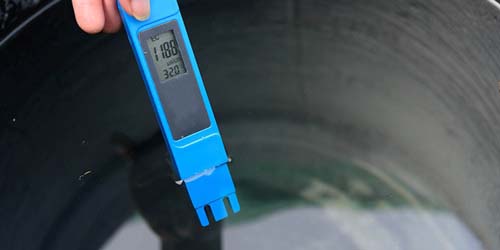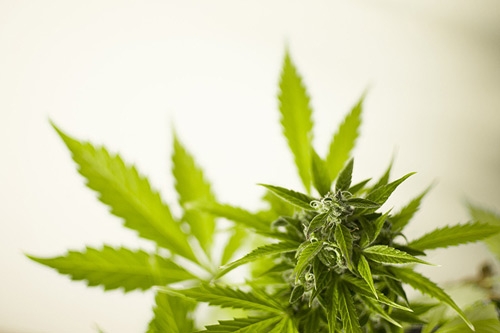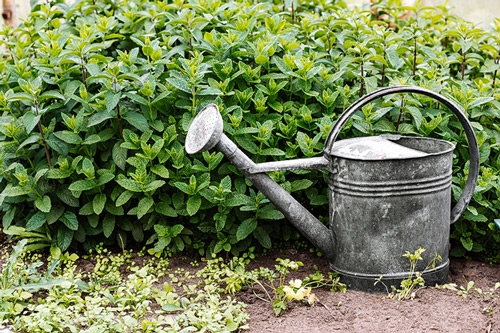
The EC value in weed growing is often not very clear, while the basics are not difficult. You measure the amount of nutrition in water and nutrient medium through conductivity. Yet, as with any subject in weed growing, there is much more to be said about it. Understanding and adjusting the EC-value is especially important for advanced forms of growing weed. This is because you can increase your yield, but also grow in mediums other than soil. For beginners who are growing in soil this info is nice, but not essential.
Meaning of EC
EC is an English abbreviation for Electrical Conductivity; or electrical conductance. You can measure the conductivity of anything and everything. For example, how well current flows through your finger. But when growing weed we are mainly interested in the conductivity of the nutrient water and soil we grow in.
This measure tells us something about how much nutrient is in the soil or water. So you know how much plant nutrition you need to give. So with an EC meter you measure an indication of the amount of nutrients in the soil. If the EC value is on the low side, your weed plant will be malnourished. Are you a feeder? Then you will see your EC value rise and you will have other problems such as "burnt" leaves. Your plants will become so saturated with nutrients that they will suffocate.
With an EC meter you measure an indication of the amount of nutrients in the soil.
The EC value is expressed in mS/cm2 (milliSiemens per square centimeter). However, sometimes you will also see ppm on the packaging or instructions of your plant nutrition. The abbreviation ppm is used for parts per million, which in this case means milligrams of nutrients per liter of water. You can easily convert the two measurements with the following table. It also shows you what the desired values are for a weed plant of a certain age and with which medium.
|
EC (ms/cm) |
Hanna (ppm) |
Eutech (ppm) |
Truncheon (ppm) |
|
0.1 |
50 |
64 |
70 |
|
0.2 |
100 |
128 |
140 |
|
0.3 |
150 |
192 |
210 |
|
0.4 |
200 |
256 |
280 |
|
0.5 |
250 |
320 |
350 |
|
0.6 |
300 |
384 |
420 |
|
0.7 |
350 |
448 |
490 |
|
0.8 |
400 |
512 |
560 |
|
0.9 |
450 |
576 |
630 |
|
1 |
500 |
640 |
700 |
|
1.1 |
550 |
704 |
770 |
|
1.2 |
600 |
768 |
840 |
|
1.3 |
650 |
832 |
910 |
|
1.4 |
700 |
896 |
980 |
|
1.5 |
750 |
960 |
1050 |
|
1.6 |
800 |
1024 |
1120 |
|
1.7 |
850 |
1088 |
1190 |
|
1.8 |
900 |
1152 |
1260 |
|
1.9 |
950 |
1216 |
1330 |
|
2 |
1000 |
1280 |
1400 |
Whether your EC meter indicates an EC value or the number of ppm differs per device. With this table you can see how you can convert the most common sizes.
EC value tap water and rain water
In the Netherlands and other Western European countries, the water quality is carefully checked before it is sent into the pipes. The water company mixes magnesium and calcium with the water to keep the EC value around 0.4. On the way to the house the EC-value can increase or decrease. Therefore, the EC value of tap water is usually between 0.1 and 0.8. The EC value of rainwater is a lot lower: often only 0.05.
Why are these values important? Because the EC value of the water determines how much nutrient you can dissolve in it before your plant says: "Yes, that is too much". That magnesium and calcium that the water company adds, contributes to the total amount of nutrition of your weed plant.

Measuring EC value
In reality, with the exception of advanced growing, you don't need to measure the EC value to grow weed. Where this measurement really adds value is if you are going to grow hydro or really want to control everything in your growing schedule. You measure the EC value with an EC meter. Which in many cases looks like a pH meter, because the technology is similar. You already have an advanced EC meter for less than € 100. Stick a neatly calibrated EC meter in your nutrient water and you immediately know the EC value - just as simple as our pH meters.
If you are growing in soil you can measure the EC value by taking a sample of 250 ml of soil. You moisten that with 150 ml of demineralized water. Mix the mud well and let it settle for at least two hours. Filter out the soil and put the EC meter in the remaining water to measure the EC value of the soil.
When hydro growing When hydro growing in a circular system, such as deep water culture, you absolutely have to take the EC value into account. Measure the EC value of the nutrient container every day and see if your plants have absorbed more or less nutrient that day. If today's EC is lower than yesterday's, you can give your plants a richer nutrient solution. Your weed plants have then absorbed more nutrition than was given. But if the EC value is higher than the day before, this means that your plants have absorbed more water than nutrition. Then the feed water is too rich and you will have to adjust it downwards.

Adjusting EC Value
This is the part where we start throwing numbers around. What the correct EC value is, depends on a number of factors. You have already seen some of these factors in the table above. So the medium is important, but also the age and stage of your weed plant. The rule of thumb is that the older the weed plant gets, the more nutrition it can tolerate/need. Every week you can add about 0.1 to the desired EC value.
Do not feed a plant that has just germinated. The spring water or tap water you give, together with the seed itself, provides enough nutrition. EC value in the soil 0.8-1 (400-500 ppm).
Seedlings can be gently fed. EC value in soil 1-1.3 (500-600 ppm).
A mature weed plant can be given more and more nutrition from the beginning of the growth phase until the penultimate week of flowering. EC value in soil 1.6 in the first week of growth (800 ppm). In the last week before rinsing 2.3 (1150 ppm).
Indicas, Sativas and Measurement Deviations
While tall, slender sativas can manage with a little less, wide-set indicas like to have plenty of food at the table. This is why the maximum EC value for Indicas is often higher than for Sativas. Don't take our numbers too closely, by the way, because there are many factors that influence the EC value. Just look at the influence of temperature on your measurement. Try to keep your water at 25 degrees Celsius, because 1 degree difference can already give a measurement deviation of 2.5%.